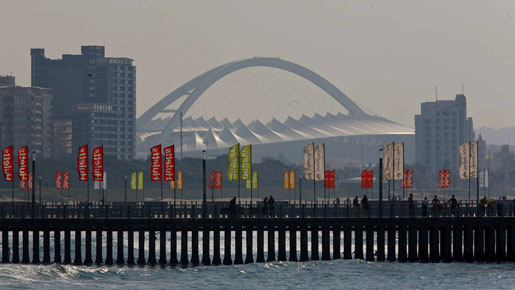
The city of Durban, the third biggest in South Africa, and one of the host cities of the 2010 Fifa World Cup of football, has a bold plan to rival India as a hub for global call centres. According to the Durban Investment Promotion Agency, the metropolis is an ideal location because of its advanced communications infrastructure, location within the same general time zone as Europe, and English language skills.
The agency, the major vehicle for attracting business to the city, says the centres can be established at roughly half the cost applying in Europe and North America. The centres form a key element of the long term business strategy for Durban, a highly international city that is home to the nation’s major port, several multi-national giants of the steel and commodities industries at the nearby Richards Bay industrial zone, and major manufacturers.
DIPA represents the eThekwini municipality, the economic hub of the Kwa-Zulu-Natal region. According to the latest available figures, the local economy is valued at around 140bn rand ($15.1bn) a year, making it the third-largest in South Africa. Working in partnership with other local authorities, the agency has a brief to ‘stimulate economic growth and facilitate sustainable new investment’ in the metropolis. In short to expand the local GDP.
As such, it aims to identify and develop new investment and commercial infrastructure, especially for disadvantaged groups in a city where unemployment hovers around 30 percent. And call centres are very much part of the grand plan. According to economists, the city can fairly claim to be the ‘smart city’ because of a comprehensive and expanding fibre optic system. Additionally, statistics reveal Durban to be a highly affordable location – its basket of costs for rates and services is the lowest of any South African city.
Meantime, the municipality continues to invest. It deploys a substantial annual budget of some 17bn rand ($1.9bn) to upgrade infrastructure, and it has pumped a further 6bn rand ($670m) into tourism, stadium and other facilities for the World Cup. Similarly, the eight year-old Durban international conference centre has just had a 460m rand ($51m) refurbishment.
This capital programme comes on the back of a healthy economic growth rate of more than six percent, and has helped the region weather the credit crunch surprisingly well. DIPA points to the city’s investment grade credit rating of AA+ as evidence of the effectiveness of its spending programme. Despite the downturn, it says, business confidence remains high with ‘positive impact on fixed capital formation’.
However, until Durban leverages its ‘smart city’ status into a major hub for call centres, its prosperity remains firmly founded on the port. The busiest in Africa, it handles some 4,000 commercial vessels a year. As such, it is a vital link in the nation’s export chain and, as the agency points out, provides a competitive advantage for the metropolitan area’s substantial manufacturing sector.
And although the municipality is investing in the new economy, it is not neglecting the old. Because of its dominant position in the maritime commerce of the south-west Indian Ocean, the port has long suffered from congestion and is now the recipient of an ambitious onshore and offshore capital program to increase capacity.
This enables DIPA to continue to attract new business around the port as well as around the ‘smart city’.

